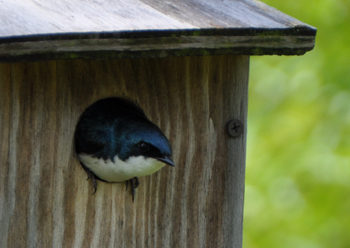A year ago we put up a couple of bluebird nest boxes at NRPA headquarters. I have often thought that the landscaped grounds around HQ were perfect habitat for Eastern bluebirds, and that if we put up nest boxes in the right locations that we could attract a pair of bluebirds to nest in them. Bluebirds are a highly threatened songbird species that is in need of conservation. So, it has been with considerable pleasure that we have been able to watch a pair of bluebirds raise and fledge five young this spring from a box in the memorial tree grove. And to add to our wildlife viewing enjoyment, this week baby tree swallows hatched in a second nest box located just behind the building along the trail around the pond.

The baby tree swallows that just hatched a couple of days ago are very tiny and nestled deep in a finely crafted nest of dried pine needles topped with an insulating ring of feathers. The babies are fuzzy little nestlings who have not quite opened their eyes yet, but they will grow fast. Even so, until they become large enough to fly from the box on their own in about 16 to 18 days, they will be totally dependent on their parents to bring them food and to keep them warm and dry during rainy days and cool nights. The nest box will become crowded as the young ones double and then even triple in size before they finally leave the nest.
Tree swallows are one of five species of swallows commonly found in the Eastern U.S. (and are closely related to the barn swallows that also build their nests at the NRPA headquarters on ledges under the eaves of the roof). Tree swallows are migratory--they winter in Mexico and Central America, and return to the U.S. and Canada each spring to build a nest in natural cavities and man-made nest boxes. They generally nest close to water’s edge near a pond, lake or marsh, and they will even nest directly over water if there is a suitable nest site. Tree swallows primarily eat mosquitoes, but they also consume other insects as well as berries from plants such as Virginia creeper, red cedar, and bayberry.
All swallows are beneficial to man, but tree swallows have a special grace in flight that make them a welcome addition to any pond or wetland.
Like many other cavity-nesting songbirds in the Eastern U.S., tree swallows have declined in numbers due to loss of habitat, competition from non-native species, and lack of suitable nest sites. The good news is that tree swallows, bluebirds, chickadees, titmice and other cavity nesting songbirds will all nest readily in man-made nest boxes. Volunteer conservation efforts are restoring these valuable species across their range, especially in parks and on public lands.
Has your agency done any similar conservation projects such as man-made nest boxes? What are some of your success? Share with us in the comments below or send us some photos via Facebook!
For more information on how you can identify suitable habitat, build nest boxes for tree swallows and bluebirds, and attract them to your parks, visit the website of the North American Bluebird Society or that of the National Wildlife Federation.
Richard J. Dolesh is NRPA’s Vice President for Conservation and Parks.

